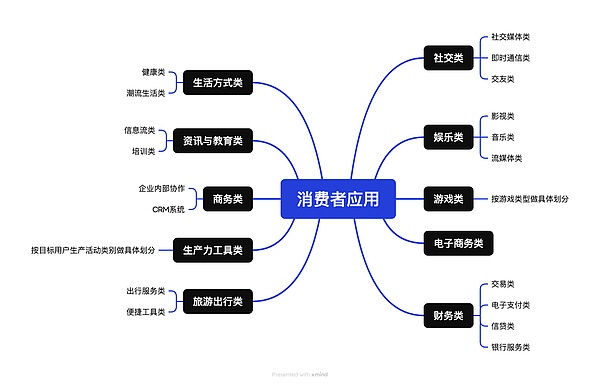
author: @Web3Mario
summary: Market sentiment has been relatively sluggish recently. As potential policy dividends gradually become fulfilled and a series of celebrities such as Trump have harvested the liquidity of the Crypto speculative market for two years, driven by the return of liquidity driven by macro-positive benefits, seems to have come to an end.In this regard, more and more investors and believers have begun to think about the next value narrative of the Web3 industry, and the Web3 consumer application track has become the focus of many discussions. Only when there are more Mass Adoptions of consumer-level applications can real user adoption and sustainable business value to this over-constructed ecosystem of infrastructure.Therefore, during this period, the author has been thinking about the issues about Web3 consumer applications.I hope to share some experiences with you.In this article, we will give a review of the current mainstream paradigm of Web3 consumer applications and explore their respective opportunities and challenges.In subsequent articles, the author will continue to share some specific market opportunity insights and ideas, and welcome friends to communicate with the author.
What is Web3 Consumer Application
The so-called Consumer Application, which is the To C application in the Chinese context, means that your target users are most ordinary consumers, not enterprise-level users.Open your App Store, and all the applications in it fall into this category.Web3 Consumer Application refers to consumer-oriented software applications with Web3 characteristics.
Generally speaking, according to the classifications in most App Stores, we can roughly divide the entire Consumer Application track into the following 10 categories, and each category will have a different segment.Of course, as the market matures, many new products will combine multiple characteristics to a certain extent in order to find their own different selling points, but we can still simply classify them according to their own core selling points.

What are the current Web3 Consumer Application paradigms and their respective opportunities and difficulties?
As of now, I think there are three common paradigms for Web3 Consumer Application:
1.Using the technical features of Web3 infrastructure, optimize some problems existing in some traditional Consumer Applications:
This is a relatively common paradigm. We know that a large amount of investment in the Web3 industry revolves around infrastructure construction, and application creators who adopt this paradigm hope to take advantage of the technical characteristics of Web3 infrastructure to enhance the competitive advantages of their own products, or provide new services.Usually we can classify the benefits brought by these technological innovation directions into the following two categories:
-
Extreme privacy protection and data sovereignty:
-
Points of opportunity:The privacy track has always been the main theme of Web3 infrastructure innovation. From the initial identity confirmation system of asymmetric encryption algorithms, a number of software and hardware technologies have gradually been integrated, such as ZK, FHE to TEE, etc.The tech giants in Web3 seem to uphold the extreme sexual misconception, aiming to create a network environment that is completely independent of third-party trust and provide users with information or value interactions.The most direct benefit of this technical feature is that it brings data sovereignty to users, and personal privacy information can be directly hosted in local trusted software and hardware devices, avoiding the leakage of privacy information.There are many Web3 Consumer Applications optimized for this technical feature. Any project that claims to be a decentralized XX belongs to this type of paradigm, such as decentralized social media platforms, decentralized AI models, decentralized video websites, etc.
-
difficulty: After years of market verification, it can be said that this is the core selling point and has not been observed in market competition. There are two reasons. First, the importance of consumer users on privacy is based on large-scale privacy leakage and infringement incidents. However, in most cases, the formulation of more complete laws and regulations can effectively alleviate this problem. Therefore, if the protection of privacy is based on more complex product experiences or more expensive usage costs, its competitiveness will be obviously insufficient.Secondly, we know that the current business model of most consumer applications is based on the value of big data extraction, such as precision marketing.Excessive emphasis on privacy protection will shake the mainstream business model because user data will be scattered among a number of data islands, which brings difficulty to designing a sustainable business model. If you can only rely on the so-called “Tokenomics”, you will have to introduce unnecessary speculative attributes to the product. On the one hand, this disperses the team’s resources and energy to deal with the impact of this attribute on the product. On the other hand, it is not conducive to finding PMF. This will be analyzed in detail below.
-
Low-cost global and 24/7 trusted execution environment:
-
Points of opportunity: The emergence of many L1 and L2 provides application developers with a new, global, and trusted program execution environment for all parties.Generally speaking, traditional software service providers independently maintain their own programs, such as running on their own server clusters or clouds, which naturally brings trust costs when businesses involving multi-party collaboration, especially when the strength or scale between multiple parties is balanced, or when the data involved is particularly sensitive and critical, and this trust cost is usually converted into huge development costs and user usage costs, such as cross-border payments and other scenarios.Using the execution environment brought by Web3 can effectively reduce the costs associated with opening such services.Stablecoins are a great example of such applications.
-
difficulty: From the perspective of cost reduction and efficiency improvement, this is indeed a competitive advantage, but it is difficult to explore application scenarios.As mentioned above, only in a certain service, if multiple parties are involved in collaboration, and the relevant entities are independent, the scale is balanced, and the data involved is particularly sensitive, the use of this execution environment brings benefits, which is a relatively harsh condition.At present, it seems that most of this type of application scenarios are concentrated in the field of financial services.
2.Use crypto assets to design new marketing strategies, user loyalty programs or business models:
Similar to the first point, application developers who adopt this paradigm also hope to add competitive advantages to their products in a relatively mature and market-verified scenario by introducing Web3 attributes.However, this part of application developers prefer to design better marketing strategies, user loyalty plans, and business models by introducing crypto assets and using the extremely high financial attributes of crypto assets.
We know that any investment target has two values, commodity attributes and financial attributes. The former is related to the use value of the target in a certain actual scenario, such as the habitable attributes of real estate assets, while the latter is related to its transaction value in the financial market. This transaction value in the crypto asset field usually comes from the investment airport scenario brought by circulating and high volatility.Crypto assets are an asset class whose financial attributes are much higher than commodity attributes.
In the eyes of most such application developers, introducing crypto assets can usually bring three benefits:
-
Reduce customer acquisition costs through Token-based marketing activities such as Airdrop:
-
Points of opportunity:For most consumer applications, low-cost customer acquisition is a key issue in the early stages of the project.With its extremely high financial attributes and assets created out of thin air, tokens can significantly reduce the risks of early projects. After all, compared to directly using real money to buy traffic, expose, and using tokens created at zero cost to capture users is indeed a cost-effective choice. From a certain perspective, this type of token is similar to an advertising token.There are many projects that adopt this paradigm, such as most TON ecological projects and mini-games belong to this category.
-
difficulty: This method of customer acquisition mainly faces two problems. One is the cost of conversion of seed users through this. We know that most of the users attracted by this plan are cryptocurrency speculators, so these users are not so concerned about the project itself, and are more concerned about the potential financial attributes. Moreover, there are currently a large number of professional airdrop hunters or hair-pulling studios, which brings great difficulties to convert them into real product users in the later stage.It may also cause the project to misjudgment of PMF, thereby causing excessive investment in the wrong direction.Secondly, with the large number of applications of such models, the marginal benefits of acquiring customers with Airdrop are reduced, which means that if you want to establish sufficient attractiveness among the cryptocurrency speculator group, the cost will gradually increase.
-
User loyalty program based on X to Earn:
-
Points of opportunity:Retention and promotion of activation are another concern for consumer applications. How to ensure that users continue to use your products requires a lot of energy and cost.Similar to marketing, using the financial attributes of Tokens to reduce the cost of retention and activation is also called the choice of most such projects.A more representative model is X to Earn, which is based on the token rewards for pre-set key user behaviors, and establishes a user loyalty program based on this.
-
difficulty: Relying on users to earn profits to promote activation will cause users to shift their focus on the product from the product function itself to the rate of return. Therefore, if the potential rate of return decreases, users’ attention will also be quickly lost, which is a great harm to consumer applications, especially some products that rely on a large amount of UGC.If the yield is based on the price of the token issued by oneself, it will put pressure on the project party to manage the market value, especially in the bear market stage, and have to bear high maintenance costs.
-
Use the financial attributes of Token to directly realize:
-
Points of opportunity: For traditional consumer applications, there are two most common business models. One is free use, using the platform traffic value after large-scale adoption, and the other is paid use. If you want to use certain Pro services of the product, you need to pay a certain fee.However, the former has a longer period, while the latter is more difficult.Therefore, Token has brought a new business model, that is, to use the financial attributes of Token to directly cash out, that is, to directly sell coins to cash out the project.
-
difficulty: It can be clearly stated that this is an unsustainable business model. The reason is that when the project development passes through the early high growth stage, due to the lack of incremental capital inflows, this zero-sum game model will inevitably allow the interests of the project party to stand opposite to the user’s interests and accelerate user loss. If it is not actively cashed out, due to the lack of robust cash flow revenue, the project party can only rely on financing to obtain funds to maintain the team or business expansion, and this will fall into the dilemma of relying on the market environment in his eyes.
3.Fully serves Web3 native users and solves the unique pain points of this part of users:
The last paradigm refers to consumer applications that fully serve Web3 native users.According to the direction of innovation, it can be roughly divided into two categories:
-
Construct new narratives, monetize designs around certain unmined value elements of Web3 native users, and create new asset classes:
-
Points of opportunity: By providing new speculative targets (such as SocialFi track) for native Web3 users, the advantage is that they have the right to pricing a certain asset in the initial stage of the project, thereby obtaining monopoly profits. This can only be achieved through fierce market competition in traditional industries.
-
difficulty: Frankly speaking, this paradigm relies more on team resources, that is, whether it can be recognized and supported by people or institutions with strong appeal among native Web3 users, or with the “pricing rights” of crypto assets.This brings two difficulties: First, with the development of the market, the pricing power of crypto assets is dynamically transferred between different groups, such as from the initial Crypto OG, it was transferred to crypto VCs, then to CEXs, then to crypto KOLs, and finally to traditional politicians, entrepreneurs or celebrities.In this process, whether it is possible to identify trends every time the rights transition and establish cooperation with upstarts has great requirements for team resources and market sensitivity.Secondly, in order to establish a partnership with “pricemakers”, it usually costs a lot and cost, because in this market, you are not competing with other competitors for a larger market share in a certain application track, but competing with all other crypto asset creators to the preferences of “pricemakers”, which is a very competitive game.
-
By providing new tool-based products, we serve the unmet needs of Web3 native users in the process of participating in the market.Or provide better and more convenient products for these users from the perspective of user experience:
-
Points of opportunity: The author believes that this is the most promising paradigm in the future. With the gradual popularization of cryptocurrencies, the overall base of this user group will gradually expand, which brings possibilities to user segmentation.Moreover, because it focuses on the real needs of a certain user group, such products are often easier to achieve PMF, thereby establishing a more robust business model, such as some transaction-related data analysis platforms, Trading Bots, information platforms, etc.
-
difficulty: Due to the return to real user needs, although the development path of the product is more robust, the construction cycle is longer than other paradigm projects. Since such projects are not narratively driven, but are driven by specific demands, the PMF of the product is easier to verify, and large amounts of financing are usually not available in the early stages of the project. Therefore, it is difficult to be patient and stick to the original intention in the complex wealth myths brought by “coin issuance” or high-valuation financing.
Of course, these three paradigms are not completely independent. You can see their shadows in many projects at the same time. It is just that we do this classification for the convenience of analysis.Therefore, for those who want to start a business in the Web3 Consumer Application track, comprehensively evaluating their own advantages and demands and choosing a paradigm that suits them the most is the top priority.








